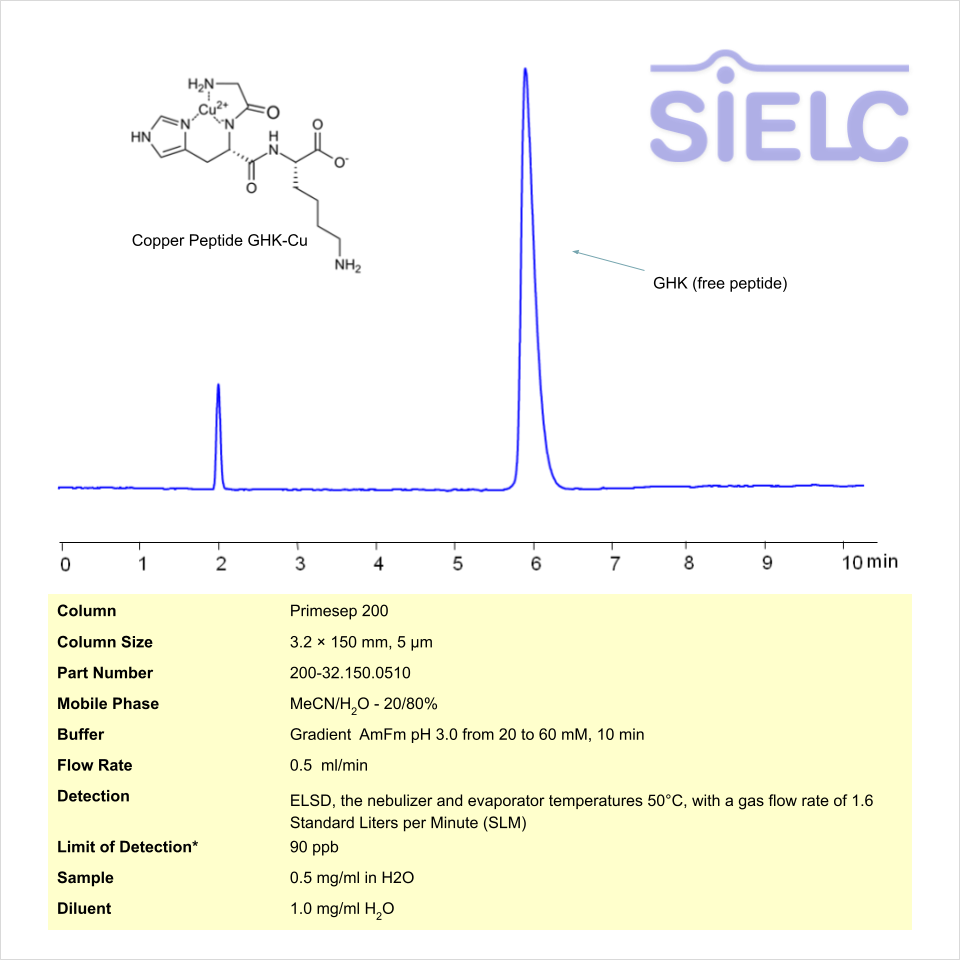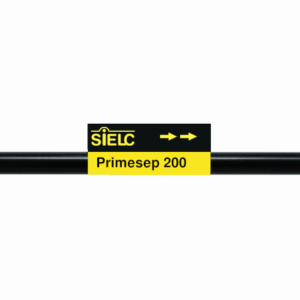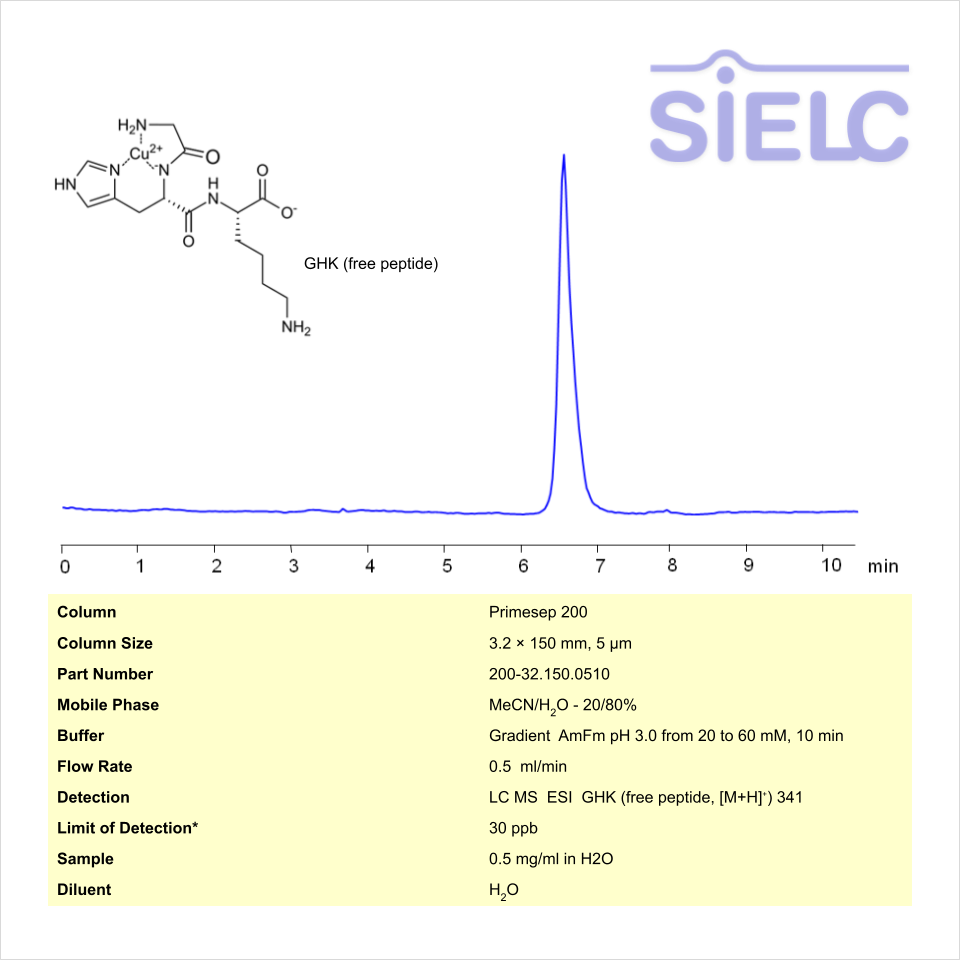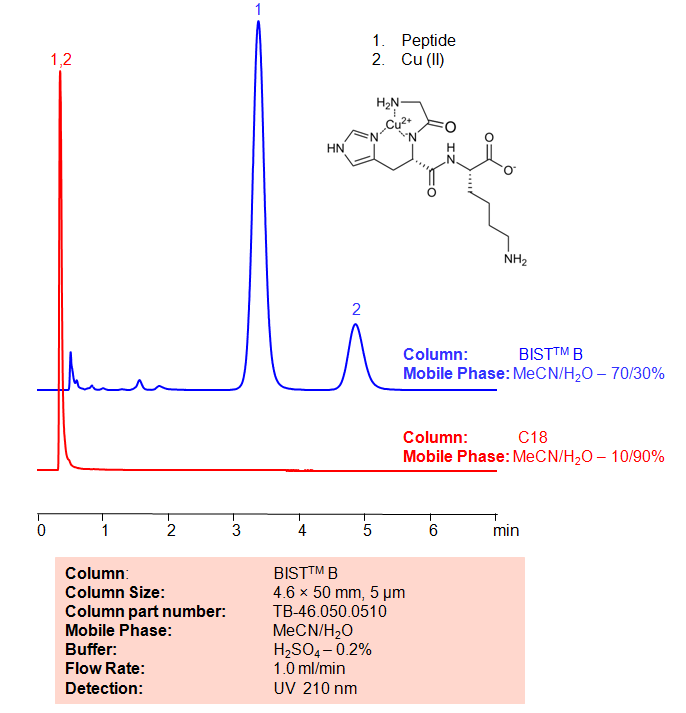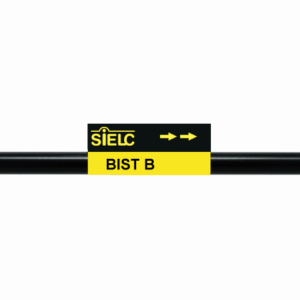| Molecular Formula | C14H23CuN6O4+ |
|---|---|
| Molecular Weight | 402.92 |
| InChI Key | NZWIFMYRRCMYMN-UHFFFAOYSA-M |
| Synonyms |
|
Applications:
HPLC ELSD Method for Analysis of Copper Peptide GHK-Cu on Primesep 200 Column
September 24, 2025
HPLC Method for Copper peptide (GHK-Cu) on Primesep 200 by SIELC Technologies
High Performance Liquid Chromatography (HPLC) Method for Analysis of Copper peptide (GHK-Cu)
Copper Peptide GHK-Cu is a naturally occurring copper complex with the molecular formula C14H22CuN6O4•C2H4O2. Research shows that the complex facilitates faster wound healing, improved angiognesis, and elevated level of antioxidant enzymes. Often times, it is used in anti-aging cosmetics.
Copper peptide (GHK-Cu) can be retained and analyzed using the Primesep 200 stationary phase column. The analysis utilizes a gradient method with a simple mobile phase consisting of water and acetonitrile (MeCN) with a ammonium formate buffer. Detection is performed using ELSD.
*LOD was determined for this combination of instrument, method, and analyte, and it can vary from one laboratory to another even when the same general type of analysis is being performed.
| Column | Primesep 200, 3.2 x 150 mm, 5 µm, 100 A, dual ended |
| Mobile Phase | MeCN – 20% |
| Buffer | Ammonium formate |
| Flow Rate | 0.5 ml/min |
| Detection | ELSD |
| Class of Compounds | Complex |
| Analyzing Compounds | Copper peptide (GHK-Cu) |
Application Column
Primesep 200
Column Diameter: 3.2 mm
Column Length: 150 mm
Particle Size: 5 µm
Pore Size: 100 A
Column options: dual ended

HPLC MS Method for Analysis of Copper Peptide GHK-Cu on Primesep 200 Column
September 23, 2025
HPLC Method for Copper peptide (GHK-Cu) on Primesep 200 by SIELC Technologies
High Performance Liquid Chromatography (HPLC) Method for Analysis of Copper peptide (GHK-Cu)
Copper Peptide GHK-Cu is a naturally occurring copper complex with the molecular formula C14H22CuN6O4•C2H4O2. Research shows that the complex facilitates faster wound healing, improved angiognesis, and elevated level of antioxidant enzymes. Often times, it is used in anti-aging cosmetics.
Copper peptide (GHK-Cu) can be retained and analyzed using the Primesep 200 stationary phase column. The analysis utilizes a gradient method with a simple mobile phase consisting of water and acetonitrile (MeCN) with a ammonium formate buffer. Detection is performed using LC MS.
*LOD was determined for this combination of instrument, method, and analyte, and it can vary from one laboratory to another even when the same general type of analysis is being performed.
| Column | Primesep 200, 3.2 x 150 mm, 5 µm, 100 A, dual ended |
| Mobile Phase | MeCN – 20% |
| Buffer | Ammonium formate |
| Flow Rate | 0.5 ml/min |
| Detection | LC MS ESI GHK (free peptide, [M+H]+) 341 |
| Class of Compounds | Complex |
| Analyzing Compounds | Copper peptide (GHK-Cu) |
Application Column
Primesep 200
Column Diameter: 3.2 mm
Column Length: 150 mm
Particle Size: 5 µm
Pore Size: 100 A
Column options: dual ended

HPLC Method for Analysis of Copper peptide GHK-Cu on BIST B Column
June 2, 2022
Separation type: Bridge Ion Separation Technology, or BIST™
High Performance Liquid Chromatography (HPLC) Method for Analysis of Copper peptide GHK-Cu
Copper peptide GHK-Cu is a copper complex of glycyl-L-histidyl-lysine and can be naturally found in urine, saliva, and plasma. Research has shown that it may promote wound healing, attract immune cells, stimulate collagen, and act as an antioxidant and anti-inflammatory compound. Using SIELC’s newly introduced BIST™ method, Copper peptide GHK-Cu, which separates in water, can be retained on a positively-charged anion-exchange BIST™ B column. There are two keys to this retention method: 1) a multi-charged, negative buffer, such as Sulfuric acid (H2SO4), which acts as a bridge, linking the positively-charged Copper and peptide to the positively-charged column surface and 2) a mobile phase consisting mostly of organic solvent (such as MeCN) to minimize the formation of a solvation layer around the charged analytes. Using this new and unique analysis method, Copper peptide GHK-Cu can be separated, retained, and UV detected at 210 nm
| Column | BIST B, 4.6×50 mm, 100A |
| Mobile Phase | MeCN – 70% |
| Buffer | H2SO4 – 0.2% |
| Flow Rate | 1.0 ml/min |
| Detection | UV 210 nm |
| Class of Compounds | Peptide, Metal |
| Analyzing Compounds | Copper peptide GHK-Cu |
Application Column
BIST B
BIST™ columns offer a unique and effective way to achieve separations that were traditionally challenging or even impossible with other HPLC columns. With the use of a special mobile phase, these ion exchange columns provide very strong retention for analytes with the same charge polarity as the stationary phase, unlocking new chromatography applications. What makes BIST™ columns stand out is their proprietary surface chemistry, which results in superior selectivity, resolution, and sensitivity. These columns offer a simple, efficient solution for a variety of analytical challenges, making them an excellent choice for researchers and analysts across many different fields. To learn more about the technology that powers BIST™ columns and to explore related applications, check out https://BIST.LC.
Select options

